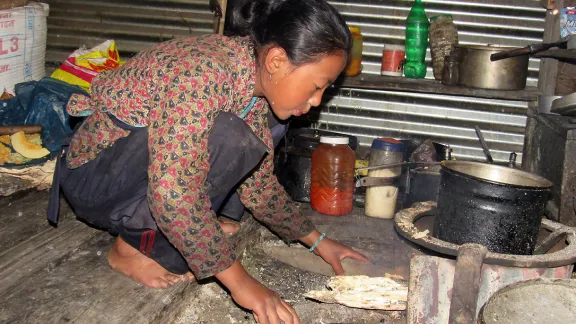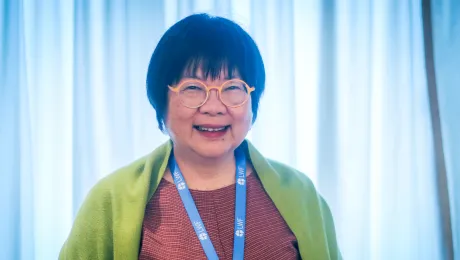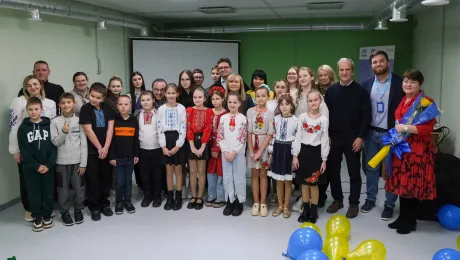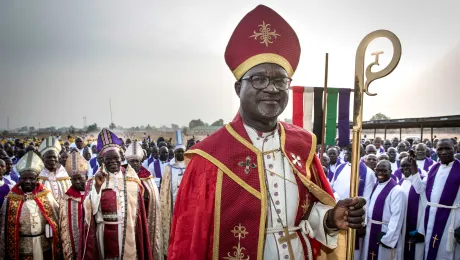
Nima Chhiyog Lama, 13, a seventh grader in Gatlang prepares food and takes care of her siblings before school. Surviving the earthquake is like being given a second life, she says. Photo: LWF Nepal
Girls aim high in earthquake-affected Gatlang
(LWI) – Thirteen-year-old Nima Chhiyog Lama still dreams about the small cozy room in her old house. A warm place, her family around her and the wood fire burning in the kitchen - much like many other houses in Gatlang.
The village in Nepal´s Rasuwa district is remote, located high in the Himalayas. It is a tourist destination on the Tamang heritage route and a stopover on the trekkers heading to Langtang.
The room in Nima´s dream was destroyed by the powerful April 2015 earthquake in Nepal. “When I wake up, I find myself on a bed made of mats and ragged clothes where my parents and two siblings sleep together. We have to fold our legs so we all fit,” she says.
Nima wants to go through the books she keeps beside the bed and start her schoolwork, but the biting cold under the temporary shelter of corrugated iron sheets makes her shiver, so she often decides to stay under the blankets instead until it is time to do the morning chores: cleaning, cooking and taking care of her siblings before going to school, where she is in the seventh grade.
Corrugated iron shelter a luxury
Nima's life is that of most young girls in Gatlang. The earthquake that struck Nepal destroyed every one of the traditional black houses in the little village. People died that day, and with them, many cattle, chicken and other domestic animals that form the livelihood of the people. With the help of The Lutheran World Federation (LWF), the people of Gatlang are rebuilding their lives.
Selestina Tamang, 14, another teenager in Gatlang, remembers the days immediately after the disaster.
“Presently, we have a luxurious lifestyle compared to this time last year when we had to fight each other for a single tarpaulin. Those who received one were considered wealthy,” she says. With 700,000 houses destroyed, many in remote villages like Gatlang, relief goods such as blankets and tarpaulins were soon out of stock nationwide. It took time to transport all that was needed to places like Gatlang. The trucks belonging to aid organization had to slowly climb steep and narrow dirt roads in the world´s highest mountain range.
“We had almost no food to eat and no warm clothes to wear in the freezing cold - I do not even want to remember what it was like to live under the open sky,” Selestina says about that time 18 months ago.
When LWF Nepal arrived in Gatlang, food, emergency shelter kits, warm clothes, blankets and sanitary items were most needed. Once the immediate needs of the population were addressed, LWF Nepal provided the village with corrugated iron roofing sheets as a medium term shelter solution, as tarpaulins would not have been able to ward off the impending monsoon. The people received livelihood support in order to become self-sufficient again.
Repaired water supply frees up time for school
For girls like Nima and Selestina, however, another form of relief was most important: LWF repaired and improved the water supply system. “Now we have clean drinking water in our vicinity, otherwise girls like me had to spend long time to fetch water from the nearby taps,” Selestina says.
Ninth grader Lakpa Mindo agrees. “Due to support from different organizations to restore and rehabilitate the drinking water supply system in a public place nearby, we have been able to give more time to our study,”
It is not only the improved water supply system that supports the girls’ education. Young girls were one of the target groups for a psychosocial support project designed to help them deal with the trauma of the disaster.
“Like everyone in the community, girls were frightened by the frequent aftershocks. Their engagement in the community psychosocial activities and cultural programs was beneficial to improve their wellbeing. The activity helped the girls to deal with the experience and to continue school,” Ganga Rai, LWF Nepal former psychosocial officer said.
The girls’ school was closed for about two months after the earthquake. Many students, particularly girls, were hesitant to continue even after it reopened, because they felt they would be needed at home or because of fear the building might collapse again. LWF opened a counseling service to encourage girls to continue their education.
“Use my time to do something good”
For Nima, Selestina and Lakpa, the earthquake also changed the way they look at life. “I am feeling as if I have been given a second birth and therefore would like to utilize my time to do something good for the society,” says Lakpa.
According to their belief, surviving the earthquake when so many others did not also means an obligation to make the best of the life that was saved, and to appreciate the help they were given.
“Struggle is something that makes you realize the goal,” Lakpa says. She is now more determined than ever to study hard and to pass her school leaving certificate with good grades. Later, she plans to take auxiliary nurse midwife and health assistant courses. Her dream is to provide health services to the poor people in remote parts of Nepal like that of her community.
(Photo and story contributed by Umesh Pokharel/LWF Nepal. Edited by LWF communications.)


